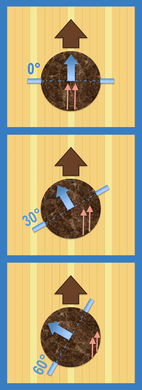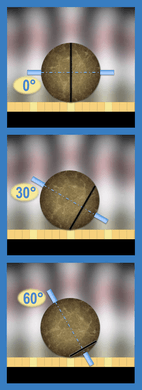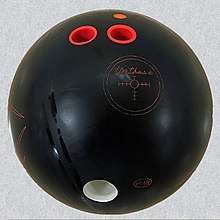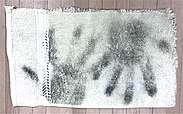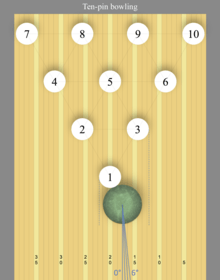Glossary of bowling
- This glossary relates mainly to terms applicable to ten-pin bowling. For candlepin terms, see Candlepin bowling#Jargon.
Numerical

Lines corresponding to angles of entry for 2°, 4° and 6°.

Spots (at 6 feet), arrows (at 15 feet), and downlane markers (at about 34-43 feet) can be used for targeting (aiming).
- 180: A pinsetter malfunction in which the sweep bar is stuck at the back of the lane, halfway through a pinsetter cycle.
- 270: A pinsetter malfunction in which the pin sweep is stuck at the front of the pin deck and the setter is unable to lower the next set of pins. In some bowling establishments, this malfunction is incorrectly referred to as 180.
Symbols
- / (slash): Symbol for spare.
A
Top views: Three angles of axis rotation (blue arrows) relative to a line parallel to the boards. Brown arrows indicate direction of overall ball motion.
Views from behind: Three angles of axis tilt (blue arrows) relative to the horizontal. Black lines on balls show ring-shaped initial contact with lane.
- ABC: American Bowling Congress, the first enduring standards and rules governing organization for ten-pin bowling in the United States, formed in September 1895[1][2][3] and merged in 2005 with other organizations to form the United States Bowling Congress (USBC).[4]
- Abralon (pad): An abrasion technology product used to "sand" ball coverstocks with different grits (degrees of roughness) to control the amount of friction between the coverstock and lane.[5][6]
- Absentee (score): See blind.
- Action bowling: Bowling contests involving money betting, historically associated with the New York underworld from the 1940s to the 1970s.[7]
- Adjust(ment): A change in technique—especially in alignment, but also in approach, delivery or targeting—often made in response to changing lane conditions or to correct undesirable ball motion.
- Align(ment): A choice of location of the feet during setup, location of the sliding foot at time of release, and choice of target (arrow), which collectively determine initial ball trajectory. Alignment is usually expressed in terms of board number and arrow number, for example, "standing at (board) 25, sliding at 20, looking at the second arrow".[8]
- Anchor: In league play, the person bowling last: usually the bowler with the highest average or the best performer under pressure.
- Andy Varipapa 300: 12 consecutive strikes bowled across two games.
- Angle of entry: The angle at which the ball is moving when first impacting a pin (especially the pocket), measured with respect to a line parallel to the lane's boards. A ball that hooks has a larger angle of entry than a ball thrown in a straight line.
- Approach: The part of the delivery that leads up to the release. Approach also denotes the area behind the foul line.
- (The) Arrows: Seven regularly-spaced arrowhead-shaped guides located about 15 feet past the foul line, used as targets for rolling the ball.
- Arsenal: The set of bowling balls available for a bowler's use. Balls in an arsenal are usually chosen to be mutually distinct in coverstock, core characteristics, and pin configuration, to achieve desired ball paths under different lane conditions.
- Asymmetric: Adjective describing a ball that is not symmetric, and therefore tending to have greater flare potential. Adjective is also applied to the ball's core.
- Average: The total of scores from multiple games divided by the number of games, rounded down to an integer (whole-number) value.
- Axis rotation: Angle of the ball's axis of rotation in a horizontal plane, measured with respect to a line parallel to the foul line. Initial axis rotation is defined at the time of release. Also referred to as side roll. Distinguish: axis tilt.
- Axis tilt: Angle of the ball's axis of rotation in a vertical plane, measured with respect to the horizontal. Initial axis tilt is defined at the time of release. Distinguish: axis rotation.
B
- Baby Split: A split which can be converted by hitting both pins with the ball. Examples: 2-7, 4-5.
- Back _#_: A number, _#_, of consecutive strikes ending with the final roll of a game. Compare: front #_.
- Back-up ball: A ball thrown with a right-handed release that hooks left to right, or thrown with a left-handed release that hooks right to left.
- Back end: The furthest (approx.) one-third of the lane from the foul line, which additionally lacks oil.
- _#_-Bagger: A string of _#_ consecutive strikes (example: "six-bagger").
- Baker format: A team game scoring format in which a team's members bowl frames in a repetitive order to complete a single game (example: bowler A bowls frames 1 and 6, bowler B bowls frames 2 and 7, and so forth).[9] Named after 1950s American Bowling Congress officer Frank K. Baker.[9]
- Balance leg: The leg opposite the leg on which a bowler slides in the final slide step, so named because the moving balance leg provides a counter-balance to the motion of the ball immediately before and during release, thus helping to stabilize the bowler's body position.[10]
- Ball reaction: Change in direction of ball motion due to frictional contact with the lane surface, the term often applied to describe the amount of hook. Often shortened to reaction.
- Ball speed: Rate at which a ball as a whole moves down the lane (usually expressed in miles per hour, MPH). Distinguish: rev rate, which describes a ball's rotational velocity (expressed in revolutions per minute, RPM).
- Beer frame: Frame in which the only bowler on a team not to strike in the frame, or the bowler with the lowest score in a predetermined frame, buys beer for his teammates.
- Benchmark ball: A ball whose coverstock, core, and layout most reliably match a bowler's style under expected lane conditions—often chosen from an arsenal as a default (first-to-use) ball.[11]
- BFO (beer frame opportunity): When three of the first four bowlers of a five-man team have struck such that if the fourth strikes, the frame will constitute a beer frame.
- Big Four: A split where only the 4, 6, 7 and 10 pins are standing.
- Blind (score): In league play, a score attributed to a team member who is absent for a particular session, the score usually smaller than his average. Also called "absentee score" or "dummy score". Distinguish: vacancy.
- Blocked lane: A lane with an oil pattern in which high oil volume on the middle boards allows a shot missed to inside to slide toward the pocket and not cross over, and in which low oil volume on the outer boards causes a shot missed to the outside to hook more strongly toward the pocket, the differing oil concentrations collectively increasing the margin of error for a strike. See typical house shot (THS). Distinguish: over/under.
- Blow-out-five (BOF):[Questionable] On a full rack, the ball hits light in the pocket, but still hits the 5-pin and makes it fly into the 7-pin (or 10-pin for left-handed releases) to strike. Broadcaster Nelson Burton, Jr. used this term. If the result of a pocket hit like this leaves a corner pin, the resulting leave is a "Swishing 7 (or 10)". Swishing 7-10 splits can even happen.
- Bo Derek: Used by Rob Stone, ten consecutive strikes in the same game, referring to the actress' best-known film.
- Board: A longitudinally placed wooden board or synthetic substitute, 39 of which constitute the 41.5-inch width of a lane. Boards are considered to be numbered 1 through 39, increasing from right to left for right-handed releases. Boards 5, 10, 15... 35 have marker arrows.
- Brackets: A contest format in which bowlers are divided into groups (the "brackets"), and each bowler is paired against another bowler in the group in the first round of what is usually a single-elimination tournament.[12] Bracket competition is often conducted in parallel with regular tournament or league competition.[12]
- Breakdown: Process by which repeated ball traversals along a path incrementally remove oil from the path so it presents increased friction to subsequently-rolled balls, thus reducing their length.[13] See also: burn. Breakdown is one aspect of lane transition. Distinguish: carry-down.
- Breakpoint: A term with slightly varying definitions: The point along a bowling ball's path at which the ball transitions from the skid phase to the hook phase; or the point of maximum change in direction; or the point at which the ball is at its most outside position. See also length.
- Brooklyn: A roll in which the ball crosses over the centerline to impact the pins on a side opposite the pocket. Also called a Jersey in the New York City area, or Windsor in the Metro Detroit area.
- Bumpers: Rails (barriers) surrounding a lane to prevent balls from going into the gutters, primarily for beginners or young children.
- Burn or burn up: Phenomenon or intentional competitive strategy by which a large amount of ball traffic on a particular path removes lane oil from that path, causing subsequently rolled balls to encounter increased friction. Term is often used to describe change in lane characteristics during long tournaments in which lanes are not repeatedly re-oiled. See breakdown.
C
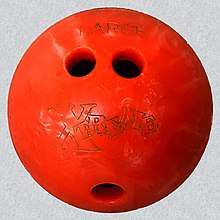
Conventional grip finger holes are relatively close to the thumb hole (compared to balls with fingertip grip).
- Carry: See pin carry.
- Carry-down: Process by which balls, having picked up oil from the oil pattern, deposit it in the normally-dry back end to cause subsequently-rolled balls to "slide" and thus extend their length before hooking.[13] Carry-down is one aspect of lane transition. Distinguish: breakdown.
- Challenge match: In Japan, an event where a popular bowler, usually a licensed professional, hosts a tournament, allowing paying participants to compete for money and prizes. Typical event consists of three games. The host receives a payment, minus the funds used to pay off the bowlers who defeated the host.
- Cherry pick: See chop.
- Chicken sandwich: Three consecutive spares, preceded and followed by strikes.
- Channel: Formal term for gutter. One of two trough-shaped structures surrounding a lane to catch errant rolls.
- Cheesy cakes: Also: "cake shot". Lanes on which strikes are relatively easy.
- Clean game: A game with a mark (spare or strike) in all ten frames.
- Chop: In an attempt to convert a spare having (at least) two pins, to knock down a near pin while failing to knock down a pin that is immediately diagonally adjacent. Example: knocking the 2 and 4 down but leaving the 5 pin. A modern interpretation of the term denotes picking only the middle pin out of, for example, the 1-3-6 or 3-6-10 (right handed release).
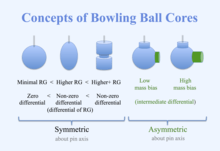
Conceptual diagram of bowling ball cores
- Closed (body position): Describes a body position in which the shoulders (especially) are directed squarely downlane and not to the outside; is commonly adopted by strokers, a style favoring repeatable accuracy over power. Compare: open (body position).
- Clover:[Questionable] Four strikes in a row. A reference to four-leaf clover.
- Cock and balls: A 1–5–8–9 leave.
- Come back: Of a ball: to hook. The term is usually applied when a ball seemingly was headed too low but ended up hooking adequately.
- Conditioner: Lubricating lane oil.
- Conventional grip or conventional fit: A ball grip in which fingers are inserted to the second knuckle from the fingertips; characteristic of house balls. Compare: fingertip grip.
- Conversion (convert): In the second ball roll of a frame, the knocking down of all pins that remained standing after the first roll, so as to achieve a spare for that frame. Term is often preceded by the number(s) of the pins involved (example: "3–6–10 conversion").
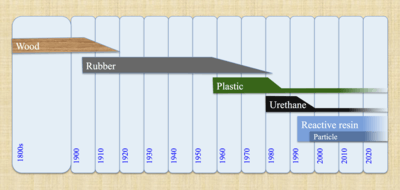
- Core: A dense structure inside a ball that can be shaped, located and oriented to strategically affect ball motion. Sometimes called a "weight block". See Bowling ball#Effect of coverstock, core and layout on ball motion
- Count: See pin count.
- Coverstock: The material comprising a ball's outer surface (cover), which determines the ball's frictional engagement with the lane and thus substantially affects ball motion. Coverstocks include polyester ("plastic"), polyurethane ("urethane") and reactive resin ("reactive").
- Cranker: A bowler who rolls the ball with high revolutions, a style favoring power over control and repeatability. Compare: stroker.
- Cross over: Of a ball: to pass from the right side to the left side of the center board (for right hand deliveries) before impacting any pins. See Brooklyn.
D
- Dead wood: A pin left on the lane or in the channel out of reach of the sweeper.
- Deck: See pin deck.
- Deck (table) jam: A pinsetter malfunction in which the pinsetter is stuck and pins fall out of it.
- Deep: See inside.
- Delivery: The process beginning with the approach and ending with the ball release.
- Differential (of RG): Difference between radii of gyration (RG) values of a ball along two axes, indicating the ball's flare potential.
- Dirk:[Questionable] See loft.
- Double: Two consecutive strikes within a single game.
- Double wood: A leave of two pins (the 2-8, the 3-9 or the rarer 1-5), the hidden one of which is called a sleeper.
- Down and in: Ball motion in which the skid is essentially parallel to the lane's boards ("down..."), generally before smoothly hooking ("... and in"). Distinguished from: skid paths that cross many boards at an angle moving toward the gutter, before hooking back.
- Downlane markers: Two pairs of three-foot long guide lines beginning 34 and 40 feet past the foul line, often used by bowlers to help determine on which board their balls reach their breakpoint.
- Drift: Lateral movement of a bowler's foot position between (initial) setup position and (final) sliding position, measured in boards left or right. Example: "a three-board drift to the left". One source calls this definition "lateral movement" and asserts that drift is more properly defined as unwanted variation away from a consistent desired lateral movement.[16]
- Dummy score: See blind.
- Dutch 200: A game consisting only of alternating strikes and spares which always results in a score of 200.
E
- Early timing: A delivery in which the ball is released before the sliding foot slides. Compare: late timing.
- Emergency service (UK): Knocking down 9 pins in three successive frames—a reference to the "999" emergency telephone number in the U.K.
- End over end: A release that imparts more forward roll on a bowling ball, as opposed to side roll. See axis rotation.
- Entry angle: See angle of entry.
F
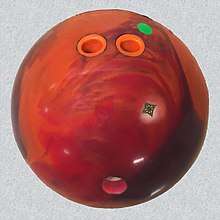
A custom-drilled ball with a fingertip grip; finger holes are relatively far from the thumb hole, compared to balls having a conventional grip.
- Fall(ing) off: Bowlers are said to "fall off (the shot)" if, soon after delivery, their bodies tip away from a stable position, especially as a result of improper balance. Opposite of posting a shot.
- Fast 8: An apparent high flush pocket hit causing the 2 pin to deflect around the 4 and 7 pins, leaving both (right-handed release).
- Field goal: A failed 7-10 split conversion attempt in which the ball goes between the two pins.
- Fill ball or Fill frame: Throw(s) after a tenth-frame spare or strike(s), needed to determine bonus points that complete ("fill") the frame.
- Finals or Final rounds: The last stage of a tournament, which in professional tournaments is usually in stepladder format.
- Fingertip grip or fingertip fit: A ball grip in which fingers are inserted only to the first knuckle from the fingertips (thumb is still inserted completely); used especially in custom-drilled balls to allow fingers to impart more rotational force. Compare: conventional grip.
- Flare: See track flare. Distinguish: a ball's flare potential.
- Flare potential: Hook potential (determined by a ball's coverstock, core, layout, speed and rev rate).[17] Distinguished from the track flare phenomenon.
- Finish: The degree of a ball surface's rough or smooth physical texture, which may be changed by sandpaper or polish. Distinguish: the microscopically-determined chemical "stickiness" characterizing reactive resin balls.
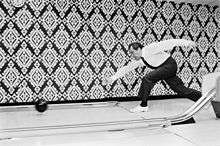
Example of a foul (left foot crosses foul line)
- Flat 10: A leave of the 10 pin, in which the 6 pin lies "flat" in the gutter. Also called "Weak 10". Compare: ringing 10.
- Flush: A full pocket hit which usually results in sending all ten pins into the pit.
- Follow-through: The continued motion of the bowling arm after ball release, used to help ensure the ball rolls over a target.
- Foul: Penalty occurrence in which a portion of the bowler's body touches beyond the foul line on a delivery in which the ball is released. The bowler receives a score of zero for that particular throw.
- Foundation frame: The 9th frame (lays a "foundation" for the final frame).
- Frame: One of ten scoring units constituting a game, each including one or two rolls (two or three in 10th frame) depending on pinfall.
- Front _#_: A number, _#_, of consecutive strikes beginning with frame 1. Compare: back #_.
- Fry Frame:[Questionable] Variant of beer frame.
- Full Murray: A 5–7–10 leave.
G
- (Go) off the sheet: See strike out. Derived during the time when bowling was scored manually on paper.
- Grandma's teeth: A 4-6-7-10 split or any "big five" split combination, resembling a mouth with missing teeth.
- Greek Church: A 4-6-7-9-10 or 4-6-7-8-10 split, resembling five spires of a Greek Orthodox church.
- Grit: A degree of roughness of an abrasive product used to "sand" ball coverstocks to control frictional engagement with the lane. Grits commonly range from 180 (rougher, for more friction and earlier hooking) to 4000 (finer, for less friction and a longer skid).[5]
- Gutter: See channel.
H
- Hambone: Commonly: four consecutive strikes within a game; coining of the term credited to announcer Rob Stone in the mid-2000s.[18] Earlier, the term denoted two consecutive strikes within a game.[18]
- Handicap: A number added to a "scratch score" to form a "handicap score". Generally, handicaps make lower-average bowlers have handicap scores that are close to handicap scores of higher-average bowlers, to make matches more evenly competitive.
- Head pin: The 1-pin.
- (The) Heads: The front part of the lane, roughly from the foul line to the arrows. Precedes the midlane and back end.
- Heavy: See high. Opposite of light.
- Hook: The second of three phases[19] of ball motion—following the skid phase and preceding the roll phase—characterized by maximum change in ball direction. Hook is mainly caused by a ball's frictional engagement with a lane in its side rotation (rotation not in the same direction as the ball's overall forward motion); hook is also affected by dynamic imbalances in the ball's internal structure (core design and orientation).
- High: Adjective describing shots that impact the pins undesirably inside from center pocket. Opposite of low.
- High flush: A strike in which the ball apparently impacts high of center pocket, but still sends all ten pins to the pit (a flush).
- House ball: A non-custom ball, generally conventional grip with polyester ("plastic") coverstock, provided by bowling facilities for use by patrons.
I

Terms describing deviations from an ideal bowling ball path
- Ice and rug: Informal name for a lane's oil pattern, including oil ("ice") for skidding on the first two-thirds (approx.), and a non-oiled, higher-friction back end ("rug") for hooking.
- Inside: The portion of the lane further to the left (for right-handed releases), often expressed in comparison to a previous ball path. As lanes transition, bowlers typically "move inside" and roll the ball inside the previous path. Distinguish: high and heavy, which usually connote where the ball impacts the pins. Opposite of outside.
K
- Kickback: Side walls outside the gutters that enclose the pin deck and support the pinsetter. Pins that strike the kickback can bounce back onto the pin deck to become messengers.
- Kickback plates: Plates that cover the kickback, against which pins bounce during pin scatter.
- Killer shot: A conversion of a split.
- Kingpin: The (centrally positioned) 5 pin.
L
- Lateral movement: See and compare: drift.
- Label: Usually refers to labeling on bowling pins, including manufacturer logo and USBC certification.
- Lane transition: Incremental changes in a lane's frictional characteristics along a path that has experienced repeated ball traversals so as to change the oil pattern and its effect on subsequently-rolled balls, a process that involves one or both of breakdown and carry-down.
- Late timing: A delivery in which the ball is released after the sliding foot slides. Compare: early timing.
- Layout: The plan of how a bowling ball's holes, pin and mass bias indicator are located relative to each other. A pin up layout has the pin "above" the finger holes (further from the thumb hole than the finger holes), whereas a pin down layout has the pin between the finger holes and thumb hole. See Bowling ball#Layout and grip.
- League: An organized group of bowling teams that compete against each other according to rules and a schedule. Leagues may be certified by a national governing body. See bowling league.
- Leave: (Noun, verb) The pins left standing after the first roll of a frame. Example: "a 10-pin leave".
- Length: The distance between the foul line and the point at which a ball enters the hook phase at the breakpoint. Length depends on oil pattern, ball surface, and delivery technique. "Length" also describes an oil pattern itself, in terms of the furthest distance past the foul line on which oil is applied.
- Light: See low. Opposite of heavy.
- Line: A ball's path down the lane, especially the substantially straight path from the foul line to the breakpoint. Also: one game (one "line" on a scoresheet).
- Line up, lining up: See alignment.
- Llama: Four consecutive strikes within a single game. More common: 4-bagger. Informal: hambone.
- Loft: (verb, noun) A thrown ball's path through the air before contacting the lane surface; also, the distance traveled on such a throw.
- Long pattern: An oil pattern that has oil distributed a relatively long distance beyond the foul line (example: 42–45 feet[20]). Also called "long oil".
- Love tap: A light pocket hit causing (for a right-handed release) the 6-pin to fall into the channel, pop back up and "tap" the 10-pin to knock it down. Distinguish: the flat 10 leave.
- Low: Adjective describing shots that impact the pins undesirably outside from center pocket. Opposite of high.
M
- Mark: (Noun, verb) A spare or a strike, distinguished from an open frame.
- Match play or Match rounds: Refers to what is usually the intermediate stage of a tournament, in which entrants compete, generally in head-to-head matches, to determine seeding for the final rounds.
- Meg:[Questionable] A roll knocking down only the 7-pin or 10-pin.
- Messenger: A pin (generally the headpin) that travels laterally across the pin deck, usually after deflecting off a side wall (kickback); also applied to a pin that knocks down other pin(s) "late" to result in a strike. Also known as a bird dog, scout, shrapnel, or rogue pin.
- Middle finger: A roll leaving only the 5-pin.
- (The) Midlane: The part of the lane between the heads and the back end.
- Mixer: A roll that causes the pins to bounce around extensively ("mix"), possibly reflecting off side wall(s); term usually distinguishes from a roll in which all pins are quickly and decisively knocked into the pit.
N
- No-tap: An alternative method of scoring in which, if a given number of pins (less than ten) are knocked down on the first roll, the frame is still scored as a strike. Example: under "nine pin no-tap" scoring, knocking down only nine pins would be scored as a strike.
- Nine-call: In Japan, a phrase used to describe an announcement over the PA system, to alert other bowlers and spectators in the establishment that a potential perfect game is about to happen. The announcement is made right before the bowler starts the 10th frame.
O
Conceptual diagrams of two oil patterns (typical house shot, and sport pattern)
(Horizontal scale is compressed)
(Horizontal scale is compressed)
Accumulated oil clogs the pores of reactive resin balls, reducing their frictional characteristics. Shown: lane oil and dirt removed from a reactive ball after twelve games.

Terms describing deviations from an ideal bowling ball path
- Oil: The lubricating conditioner applied to the front two-thirds (approximately) of the lane. See oil pattern.
- Oil pattern: Quantitative pattern of distribution of oil on the lane, having a major effect on ball motion. Oil patterns are given names (example: animal patterns such as "Scorpion", tournament patterns such as "U.S. Open", or legend patterns such as "Dick Weber 45");[21] also, "pattern" is sometimes used to particularly characterize a pattern's length (example: in "a 39-foot pattern", oil is applied only in the first 39 feet past the foul line). See typical house shot and sport pattern.
- Oil ratio: The ratio of oil concentration at the center of the lane to oil concentration near the outer edges of the lane. Typical house shots generally have oil ratios much higher than those of sport shots.
- Open (body position): Describes a body position in which the torso is directed substantially to the outside and not squarely downlane; often adopted by crankers as enabling extra power as the torso rotates from open to closed position during delivery. Compare: closed (body position).
- Open bowling: Term applied in bowling centers to denote unstructured practice sessions or fun times, as distinguished from league or tournament play.
- Open frame: A frame in which neither a strike nor spare is achieved.
- Out of range: describes a pin that has been moved off its proper spot far enough that the pinsetter cannot pick it up, sometimes jamming the pinsetter, and preventing the sweeping of downed pins; this often requires technician intervention.
- Outside: The portion of the lane further to the right (for right-handed deliveries), often expressed in comparison to a previous ball path. Typically, bowlers "move outside" to obtain a greater angle of entry to the pins without requiring a large hook. Distinguish: light and low, which usually connote where the ball impacts the pins. Opposite of inside.
- Over/under: A phenomenon in which two very slightly different rolls start on paths directed outside and inside of each other, but, against expectation, follow paths that cross each other downlane to impact the pins high and low, respectively. Common explanation: a first roll encounters unexpectedly high friction and hooks excessively so as to hit the pins too high, but a second roll delivered very slightly further inside encounters unexpectedly high oil concentration and hooks inadequately so as to hit the pins too low. Over-under may be caused by steep ("cliff") oil patterns, or by defective lane topology. Sometimes called wet/dry.
- Overlay: A type of lane surface in which a film is applied to a wood surface, protecting it while preserving some of the characteristics of a traditional wood surface.
P

Ball contacts the 1, 3, 5 and 9 pins (sequentially tinted red) to achieve what some call a perfect strike.
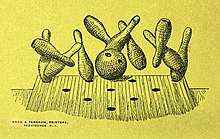
An 1895 artistic portrayal of pin scatter with two-hole bowling ball.[22]
- PAP: Abbreviation for positive axis point. The pocket-side end of a ball's initial axis of rotation, used by pro shop operators to strategically determine where to drill holes for the ball's layout.
- Par: A scratch score of 200.
- Pair: Two adjacent lanes that share a common ball return.
- Paralyzer:[Questionable] A pin knocked down that stands up again, one that skids while standing or one that gets hit on opposite sides by the ball and/or other pin(s) and somehow does not go down.
- Pattern: See oil pattern.
- PBA: Professional Bowlers Association, the international sanctioning body for professional bowlers, formed in 1958.[23]
- PBA 4:[Questionable] The 3-4-6-7-9-10 split (or 2-4-6-7-8-10 for left-handed release).
- Perfect game: A game of 12 consecutive strikes (score: 300).
- Perfect strike: A strike in which the ball hits only the 1, 3, 5 and 9 pins (right-handed release) and 1, 2, 5 and 8 pins (left-handed release).
- Pin (element of bowling ball): A usually cylindrical structure extending from the core (weight block) to the ball's cover, used as a reference point for drilling the ball. See pin up and pin down.
- Pin action: See pin scatter.
- Pin carry: The process by which pins are knocked down by direct ball impact and pin scatter. Pin carry is quantified by pin count.
- Pin chaser: Colloquial name for a bowling center's mechanic.
- Pin count: The number of pins knocked down on a given roll, usually referring to the first roll of a frame. Pin count is particularly important after mark(s) in prior frame(s), because the scoring effect of first-roll-of-a-frame pin count is doubled following a spare or single strike, and tripled following two consecutive strikes. Often shortened to count.
- Pin deck: Area of the lane on which the pins stand, immediately in front of the pit.
- Pin down: See layout.
- Pin scatter: The process by which pins interact and potentially knock each other down, usually distinguished from being knocked down directly by ball impact. Also called pin action. Pin scatter affects pin carry.
- Pin up: See layout.
- Pit: The region, behind the pin deck, that collects downed or swept pins.
- Pitch: Angle and direction at which finger holes and thumb holes are drilled.
- Pivot step: The second-to-last step in a bowler's delivery, the step immediately preceding the slide step.[10]
- Plastic: See polyester.
- Pocket: The ideal place for the ball to hit the pins in order to maximize strike probability. According to a USBC Pin Carry Survey completed in 2008, a ball ideally hits the head pin while centered 2.5 boards from the center of the head pin, on "board 17.5".[24]
- Point up: To play the lane by angling the ball from the gutter toward the pocket with more of a straight shot than hook. Distinguish: Down and in.
- Polyester: Proper name of "plastic", usually describing ball coverstocks. Polyester (plastic) balls are often chosen as straight balls.
- Polyurethane: Proper name of "urethane", describing ball coverstocks.
- Position round: A league session in which teams that are adjacent each other in the standings are paired to bowl against each other (#1 ranked vs. #2 ranked; #3 vs. #4, etc.). Also: such a pairing of bowlers in (usually) the last round of tournament match play, whose outcome will determine seeding for the subsequent (final or championship) rounds.[26]
- Post (a shot): To retain a stationary, stable, balanced position until well after the end of a delivery, a practice thought to improve consistency of delivery. Opposite of falling off (a shot).
- Power stroker: A bowler who combines a cranker's emphasis on power with a stroker's emphasis on control. Similar to "tweener."
- Post-bowl and pre-bowl: To bowl a league game after or before scheduled league time; rules vary as to availability of honor awards, and as to requirements for official witnessing and bowling opposite an opposing team.
- Preferred spin axis (PSA): The axis to which a ball's axis of rotation will migrate after having been rolled with an initial spin axis.[27] The migration is caused by dynamic imbalances in the ball's internal structure (core design and orientation).
- Pre-shot routine: A predetermined, ordered sequence of mental and/or physical steps practiced immediately before beginning a delivery, in an effort to increase consistency.[28]
- Push off or push away: The initial forward movement of the ball from the stable setup position, and preceding the backswing.
- PWBA: The Professional Women's Bowling Association (1960—2003; 2015— ) organizes professional women's bowling events.
Q
- Qualifying (rounds): The initial stage of a tournament, in which the broadest field of competitors compete to determine who will proceed to the next stage, which is usually the match rounds.
R
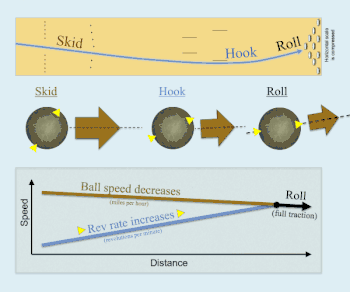
Conceptual illustration of ball speed and rev rate during the skid and hook phases, until they converge upon entering the roll phase. The initial ratio of ball speed to rev rate—the ratio at the time of release—is called the release ratio. Rev rate increases (motion of yellow arrowheads) until it matches the decreasing ball speed upon entering the roll phase.
- Rack: A full set of ten pins, either in the pinsetter or after being placed onto the pin deck.
- Radius of gyration (RG): A specification of the degree to which a ball's core is "center heavy" (minimum RG value=2.46, favoring shorter length) or "cover heavy" (maximum RG value=2.80, favoring greater length). See Bowling ball#Effect of coverstock, core and layout on ball motion.
- Rail: The 1–2–4–7 or 1–3–6–10 pins; spinners "ride the rail" after deflecting from the 1-pin. Also: "picket fence".
- Rangefinders: See downlane markers.
- Reaction: See ball reaction.
- Reactive resin (often shortened to reactive): A coverstock composition in which polyurethane is enhanced with microscopic pores and/or additives to increase frictional engagement with the lane, enabling greater hook potential.
- Release: The final stage of the delivery (occurring after the approach) in which the ball leaves the bowler's hand.
- Release ratio: The ratio of a ball's forward (translational) speed to its rev rate (rotational speed) at time of release. This ratio continually decreases throughout the ball's travel until it reaches exactly 1.0 when full traction is achieved upon entering the roll phase. See Bowling ball#Ball motion.
- Resurface: To apply a sequence of one or more abrasive pads to a ball's coverstock to achieve a chosen surface roughness, to achieve desired frictional characteristics for controlling ball motion.[6] See Abralon, Siaair.
- Rejuvenator: A machine that uses hot air to heat a bowling ball to a safe temperature to "pull" oil from the coverstock, for restoring "tack" for increasing frictional characteristics.[6]
- Re-rack: Placement of a new set of pins onto the pin deck; often performed if an earlier set had a pin off its mark, or as a tactical delay in a competitive match.
- Rev-dominant: Adjective describing a release with a too-low release ratio, in which the ratio of ball speed to rev rate is too low, causing the ball to enter the roll phase before reaching the pins, wasting power that would otherwise be imparted to the pins. Opposite of speed-dominant.
- Rev rate: (Informal) A ball's rotational speed, substantially affecting hook; usually expressed in revolutions per minute (RPM).
- RG: Abbreviation of radius of gyration.
- RG differential: See differential of RG.
- Ride the lightning: (Informal) To roll a ball close to the gutter.
- Ringing 10: A leave of the 10-pin, in which the 6-pin flies around the 10-pin to the outside and enters the pit (compare: flat 10). Also called "Solid 10". Left-handed release equivalent: "Ringing 7".
- Roll: The third phase of ball motion, in which the ball gains full traction upon leaving the hook phase.
- Roll-out: Progression from the hook phase into the roll phase of ball motion. Commonly, the term connotes undesirably early entry into the roll phase, distinguished from optimally entering the roll phase immediately before reaching the pins: early roll-out wastes power to lane friction. See release ratio.
- Rotation: See axis rotation.
- Rule of 31: A rough guideline for estimating on which board the ball should leave the oil pattern to reach the pocket. Specifically, the formula is B=L–31: board B = length L of the oil pattern in feet, minus 31. Example: Pattern length 40 ft. — 31 = 9 board.[29]
S
- Sacrificial lamb: In competitive scratch team play, a low-average bowler who is deliberately matched against a high-average bowler on the opposing team, as the team's strategy to win match-ups of the remaining players.
- Sandbagging: Intentionally bowling poorly early in a season to obtain a high handicap to apply when later bowling earnestly.
- Scout: See messenger.
- Scratch: Adjective describing scores actually achieved—without addition of a handicap.
- Series: An associated set of plural (usually three) bowling games.
- Set: See series.
- Setup: The still and stable position of the body from which bowlers launch their approaches. Setup encompasses knee bend, tilt from the waist, initial ball position, weight distribution and relative position of the two feet, etc., and is the time when the bowler focuses on the target. Verbal form: set up.
- Shadow bowling: Bowling without pins, especially for practice or warm-up, promoting focus on technique or ball motion rather than scoring result.
- Short pattern: An oil pattern that has oil distributed a relatively short distance beyond the foul line (example: 32–35 feet[20]). Also called "short oil".
- Shut out: In competition, to score sufficient points to make it mathematically impossible for an opponent to catch up with one's own score by the end of the game.
- Siaair (pad): An abrasion technology product used to "sand" ball coverstocks with different grits (degrees of roughness) to control the amount of friction between the coverstock and lane.[6]
- Six-pack: Six consecutive strikes in a single game.
- Skid: The first phase of ball motion, in which the ball travels a substantially straight path until reaching the breakpoint.
- Skid/flip: Adjective applied to balls or ball motion, in which the ball conserves energy in a long skid phase, and releases the energy by curving sharply far down-lane in the hook phase.
- / (slash): Symbol for spare.
- Sleeper: A pin positioned directly behind another pin after the first ball roll, specifically: the 8-pin behind the 2-pin, the 9-pin behind the 3-pin, or the 5-pin behind the 1-pin. The two pins are collectively called double wood. Also: "ninja pin".
- Slide step: The final step in a bowler's delivery, the step immediately following the pivot step.[10]
- Solid 8 or Solid 9: Leaving the 8-pin (for right-handed releases) or 9-pin (for left-handed releases) on a perfect pocket hit. Also called stone 8 or stone 9.
- Sombrero: Less common term for a 4-bagger (four consecutive strikes).
- Span: The distance between a ball's finger holes and the thumb hole.
- Spare: The scoring result in a frame in which the last of the ten pins is/are knocked down on the second roll of the frame. The term sometimes refers to the pins left standing after the first roll (example: "3-6-10 spare"). See conversion.
- Spare-related terms: (Terms assume a right hand release, and white numbers represent standing pins.)
| Dinner bucket Bucket if missing 8-pin | Double wood left or Sleeper #1 | Double wood right or Sleeper #2 |
|---|---|---|
| 7 8 9 10 4 5 6 2 3 1 |
7 8 9 10 4 5 6 2 3 1 |
7 8 9 10 4 5 6 2 3 1 |
| Baby split | Christmas tree #1 | Christmas tree #2 |
| 7 8 9 10 4 5 6 2 3 1 |
7 8 9 10 4 5 6 2 3 1 |
7 8 9 10 4 5 6 2 3 1 |
| Big Four | Greek Church (Big Five) | Goal (Fence- or Bed-) posts |
| 7 8 9 10 4 5 6 2 3 1 |
7 8 9 10 4 5 6 2 3 1 |
7 8 9 10 4 5 6 2 3 1 |
| Dime store #1 | Dime store #2 | Lily, Sour apple |
| 7 8 9 10 4 5 6 2 3 1 |
7 8 9 10 4 5 6 2 3 1 |
7 8 9 10 4 5 6 2 3 1 |
| Washout #1 | Washout #2 | Modern Washout (Super Washout) |
| 7 8 9 10 4 5 6 2 3 1 |
7 8 9 10 4 5 6 2 3 1 |
7 8 9 10 4 5 6 2 3 1 |
- Sparrow: Three spares in a row. Also: "chicken".
- Speed: Abbreviation for ball speed.
- Speed-dominant: Adjective describing a release with a too-high release ratio, in which the ratio of ball speed to rev rate is too high, causing the ball to reach the pins while still in the hook phase, causing unnecessarily low entry angle and increased ball deflection. Opposite of rev-dominant.
- Spinner: A bowler or bowling style imparting a high axis tilt causing the ball to spin like a top, thus promoting greater length before hooking.

Conceptual diagram of a sport pattern
(Horizontal scale is compressed)
(Horizontal scale is compressed)

Spots (at 6 feet), arrows (at 15 feet), and downlane markers (at about 34-43 feet) can be used for targeting (aiming).
- Split: A spare leave in which the head pin is knocked down but at least two non-adjacent pins remain standing with a gap between them. Example: the 9-10 leave (non-adjacent pins) is a split, but the 6-10 leave (adjacent pins) is not a split. Distinguish: washout.
- Sport pattern or sport shot: One of a number of challenging oil patterns customarily used in competitive matches and professional events, in which the distribution of oil laterally across the lane is "flat" (relatively evenly distributed) so as to provide little assistance in guiding the ball toward the pocket. Distinguish: Typical house shot (THS).
- Spots: A set of alignment dots located about six feet beyond the foul line, usable for targeting (aiming).
- Spot bowl: (Verb) To execute an approach while targeting (looking at) the spots six feet beyond the foul line, or more broadly: targeting other markers (such as the arrows) that are nearer than the pins themselves.
- Stance: The stable initial body position before the approach begins, including ball and hand/arm position, posture, and alignment of feet, knees, hips and shoulders.
- Stepladder final: A variant of the single-elimination tournament format in which the lowest-ranked finalist is first paired against the second-lowest-ranked finalist, the winner advancing to oppose the third-lowest-ranked finalist in a second game, the winner of which advances to oppose the fourth-lowest-ranked finalist, and so forth, through a final match involving the highest-ranked finalist.[30] See diagram for tournament.
- Stick: A pin, a count, or a specific pin number. Examples: "down 20 sticks" or "leave a 10-stick." Also: "wood".
- Steener: A strike in which the ball misses the head pin but pin action knocks it down. Also: "backwash", "backdoor strike". Alternative definition: a 1-pin leave.
- Stone 8 or Stone 9: See solid 8 or solid 9.
- Stewart:[Questionable] A perfect game.
- Straight ball: A ball that travels a relatively straight path, without hooking substantially. Because of their low hook potential, polyester (plastic) balls are often chosen as straight balls for converting certain spares.[31]
- Strike: (Noun, verb) Scoring result for a frame in which all ten pins are knocked down on the first roll.
- Strike out: To roll consecutive strikes from a certain frame through the end of a game. Also: "going (off the) sheet", "going to the wall", or "punching out".
- Stroker: A bowler with a style emphasizing control and repeatability over power. Compare: cranker.
- Strong: Adjective characterizing a ball (or its coverstock, layout, core design, etc.) as beginning to hook earlier and more smoothly, and experience less downlane sideways motion than a weak ball.[32][33] The term is sometimes used (incorrectly, according to some sources[32][33]) to indicate a larger overall hook potential. The first definition concentrates on length whereas the second definition concentrates on left-right motion.
- Symmetric: Adjective describing a ball whose RG (radius of gyration) values along the Y (high RG) and Z (intermediate RG) axes do not differ by more than 5% of total differential.[27] Adjective is also applied to the core itself.
- Synthetic: Adjective describing a material other than wood, usually applied to pins or lane surfaces.[27]
T

Adjusting screws placed at center and two sides of this circa 1895 bowling lane design allow adjustment of lane topography.[22]

Conceptual diagram of a professional tournament. Entrants not eliminated in qualifying rounds go on to compete in match play, which determines seeding (initial ranking) for the final matches,[34] which in PBA tournaments have often been televised stepladder finals.
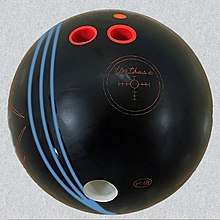
Track flare is progression of the ball's oil track (simulated in blue) reflecting migration of the ball's axis of rotation on successive revolutions.
- Tap: Differing definitions: (a) modern use: a first roll leaving only a single pin standing (comes from "9 pin no-tap" scoring, which counts such frames as strikes); or (b) historical use: a solid pocket hit that leaves a single pin in the back row.
- Target: (noun or verb) A point at or near the arrows on which bowlers focus their eyes, ideally during approach and follow-through. Most experienced bowlers consider it inadvisable to "target" (aim at) the pins. See spot bowl.
- Team USA: The U.S. national bowling team. See USA Bowling.
- Ten in the pit: A strike in which all ten pins are knocked from the pin deck into the pit.
- THS: See typical house shot.
- Tiger beer frame:[Questionable] Similar to Beer Frame except the strikes bridge two frames. Example: 4th and 5th bowlers strike in one frame, and 1st and 3rd strike in the ensuing frame, thus "hanging" the 2nd bowler. Derived from Tiger Grand Slam.[Questionable]
- Tight (lane): A lane whose conditions reduce hooking, such as through heavy application of oil.
- Tilt: See axis tilt.
- Timing: A characterization of the time the hand releases the ball compared to the time the sliding foot slides. See early timing and late timing.
- Timmy:[Questionable] Nickname for the 7 pin, or right-handed releases that knock down only the 7 pin. TIM is an acronym for Tenpin in the Mirror.
- Topography: Lane surface physical characteristics, or more specifically: a map showing deviations away from being planar (flat and smooth), continuous and level, especially if beyond specified tolerances.
- Tournament: A contest among a large number of bowlers. Some larger (and most professional) tournaments start with qualifying rounds that determine who goes on to compete in match play, which determines seeding (initial ranking) for the final matches which are usually stepladder finals.[34]
- Tracks: Bowtie-shaped rings of oil left on a bowling ball after a shot, indicating where the ball contacted the lane. See also: track flare. Track also denotes a ball's path down the lane.
- Track flare: Progression of the ball's oil track reflecting migration of the ball's axis of rotation on successive revolutions. Track flare exposes dry ball surface to the lane with each revolution, to thus increase friction and enhance ball reaction. Distinguish this track flare phenomenon from a ball's flare potential.
- Transition: See lane transition.
- Turkey: Three consecutive strikes within a single game.

Conceptual diagram of a typical house shot (THS) oil pattern
(Horizontal scale is compressed)
(Horizontal scale is compressed)
- 3 ball auto: Three non-consecutive strikes in a single game.
- Turkey sandwich: A turkey preceded and followed by spares.
- Typical house pattern: See typical house shot.
- Typical house shot (THS): Also called typical house pattern. One of a number of oil patterns commonly used to help non-sport league bowlers achieve more strikes, the patterns generally having larger oil concentrations near the centerline (to let balls slide directly toward the pocket) and with lower oil concentrations nearer the channels (to help balls hook toward the pocket). Distinguish: Sport shot.
U
- Urethane: Informal adaptation of the proper term polyurethane, applied to ball coverstocks. Balls with urethane coverstocks provide less angular hooking motion than reactive resin balls.
- Uneven frames: Marking (achieving a spare or strike) in every other frame. Distinguish: Dutch 200.
- USA Bowling: Formed in 1989 represent the sport as the national governing body and supporting Team USA, the national team. USA Bowling merged in 2005 with other organizations to form the United States Bowling Congress (USBC).[4]
- USBC: United States Bowling Congress, the standards and rules governing organization for ten-pin bowling in the United States, formed in 2005 from a merger of the American Bowling Congress (ABC) (founded in 1895), the Women's International Bowling Congress (WIBC, 1916), the Young American Bowling Alliance (YABA, 1982), and (Team) USA Bowling (1989).[4]
V
- Vacancy (score): In league play, a score attributed to a position in the team roster that has not been filled. Distinguish: blind.
W
- Wall shot: A strike involving a light pocket hit and pins (especially the headpin) bouncing off the side wall(s). See also: mixer.
- Washout: A leave in which at least two non-adjacent pins remain standing, but in which the head pin is still standing to disqualify it from being a split.
- Weak: See explanation of strong, which is the opposite of weak.
- Weight block: See core.
- Wet/dry: See over/under.
- WIBC: Women's International Bowling Congress, the governing organization for women's bowling, formed in 1916 as a counterpart to the male-only ABC, and merged in 2005 with other organizations to form the United States Bowling Congress (USBC).[4]
- Wrist brace or Wrist guard or Wrist positioner or Wrist support: A device fitted to the wrist and back of the hand to hold the wrist in a desired position, often with the goal of increasing side rotation and hook by preventing the wrist from unintentionally bending during delivery.[35]
- Wrist lag: Part of a delivery technique in which the ball is first cradled and then the wrist is uncoiled so the fingers apply a snapping action to the ball. Wrist lag is used to increase rev rate.[36]
- Wombat:[Questionable] A spare achieved after rolling a gutter ball on the first roll.
X
- X: Symbol for strike.
Y
- YABA: Young American Bowling Alliance, serving bowlers under age 22. Previously the American Junior Bowling Congress, YABA was formed in 1982 and in 2005 merged with other organizations to form the United States Bowling Congress (USBC).[4]
- Yahtzee: Five consecutive strikes in the same game.
Links to other online glossaries
- "Bowling Terms". BowlersMart.com (BowlersMart). 2020. Archived from the original on March 24, 2020.
- "Bowling Lingo". PBA.com (Professional Bowlers Association). 2010. Archived from the original on November 30, 2016. Retrieved January 21, 2019.
- "Technical Terms" (PDF). Bowl.com (United States Bowling Congress, USBC). May 2009. Archived (PDF) from the original on October 8, 2018.
- Thompson, Ted (March 20, 2010). "Bowling Terms and Glossary". Kegel.net (Kegel LLC). Archived from the original on July 5, 2018.
- "Bowling Terminology". BowlingBall.com. Archived from the original on October 4, 2016.
- "The PRS Of Bowling Terminology". BowlingBall.com. Archived from the original on October 26, 2019.
- "Bowling Term Glossary". Bowling.com. Archived from the original on January 21, 2019.
- "Bowling Glossary". Bowling2u.com. Archived from the original on May 7, 2019.
Other sources
- Freeman, James; Hatfield, Ron (July 15, 2018). "Glossary". Bowling Beyond the Basics: What's Really Happening on the Lanes, and What You Can Do about It. BowlSmart. ISBN 978-1 73 241000 8.CS1 maint: ref=harv (link)
- Rich, Carruba (August 24, 2011). "How Long Are Bowling Lanes". BowlingBall.com (Bowlversity educational section). Archived from the original on September 9, 2015. (review of lane specifications and dimensions)
gollark: Hmm, so what if we reveal that umnikos is secretly gibson?
gollark: ÆÆÆÆÆÆÆÆÆÆÆÆÆÆÆÆÆÆÆÆÆÆÆÆÆÆÆÆÆÆÆÆÆÆÆÆÆÆÆÆÆÆÆÆÆÆÆÆÆÆÆÆÆÆÆÆÆAAAAAAAÅAAAAAAAAAAAAAAAAA
gollark: Probably.
gollark: Gibson, vote gibson and help.
gollark: Well, I mean, we're apparently going backward.
References
- See "Links to other online glossaries" and "Other sources" for sourcing for entries not specifically sourced below.
- "New Rules For Bowlers / The National Congress Makes Radical Changes". The Brooklyn Daily Eagle. September 10, 1895. p. 5. Archived from the original on June 15, 2018. Accessed via Newspapers.com.
- "New Bowling Rules / They Have Been Revised and Radical Changes made". The Topeka State Journal. Kansas. September 21, 1895. p. 8. Archived from the original on May 5, 2019. Accessed via the U.S. Library of Congress online.
- "American Bowling Congress Meeting". The Daily Morning Journal and Courier. New Haven, Connecticut. January 21, 1896. p. 3. Archived from the original on May 5, 2019. Accessed via the U.S. Library of Congress online.
- "USBC, ABC, WIBC and Team USA Bowling". Bowl.com (United States Bowling Congress). Archived from the original on March 11, 2017. Retrieved March 13, 2019.
- Carruba, Rich. "Carry Your Own Bowling Ball Surface Grit Pads". BowlingBall.com (Bowlversity educational section). Archived from the original on November 2, 2019.
- "How To Bring Dead Bowling Balls Back To Life". BowlingBall.com (Bowlversity educational section). 2011. Archived from the original on November 21, 2011. Credited to article from Storm Bowling Products.
- Crockett, Zachary (March 21, 2014). "The Rise and Fall of Professional Bowling". Priceonomics. Archived from the original on March 16, 2018.
- Carruba, Rich (2012). "Line Up To The Bowling Pocket". BowlingBall.com (Bowlversity educational section). Archived from the original on August 2, 2020.
- Goodger, Jef (February 11, 2019). "Baker Team Competition Format / The Pros and Cons of Bowling's Baker Scoring System". ThoughtCo.com. Archived from the original on March 18, 2019.
- Carruba, Rich (2012). "Your Bowling Balance Leg". BowlingBall.com (Bowlversity educational section). Archived from the original on August 11, 2020.
Updated 8/10/2020
- Carrubba, Rich (2011). "Selecting A Benchmark Bowling Ball". BowlingBall.com (Bowlversity educational section). Archived from the original on September 30, 2011.
- "What Are Bowling Brackets". BowlingBall.com (Bowlversity educational section). May 2012. Archived from the original on October 23, 2016.
- Carruba, Rich (2012). "Bowling Lane Oil Carry Down And Break Down". BowlingBall.com (Bowlversity educational section). Archived from the original on June 11, 2012.
- Carrubba, Rich (June 2012). "Bowling Ball Evolution". BowlingBall.com (Bowlversity educational section). Archived from the original on September 17, 2018.
- Siefers, Nick (USBC research engineer) (April 23, 2007). "Understanding the relationship between core and cover stock". BowlingDigital.com (Courtesy of USBC Equipment Specification and Certification). Archived from the original on September 20, 2018.
- McEwen, Jason. "Do you 'Drift' on the Approach?". USBCBowlingAcademy.com. Archived from the original on March 1, 2019. Retrieved March 1, 2019.
- Padilla, Stephen (September 17, 2015). "Choosing A Bowling Ball That Is Right For Your Arsenal (USBC Moderator's Discussion)". usbcbowlingacademy.com. United States Bowling Congress. Archived from the original on July 24, 2016.
- Gorches, Steve T. (February 29, 2008). "Stone Talks Hambone". Post-Tribune. Chicago. Archived from the original on February 26, 2019.
- "Bowling Ball Reaction Keys". BowlingBall.com (Bowlversity educational section). July 28, 2016. Archived from the original on November 10, 2016.
- Davis, John (May 31, 2005). "The Long and Short of It". Kegel.net. Archived from the original on July 31, 2019.
- "PBA Oil Patterns (AKA Lane Conditions)". PBA.com (Professional Bowlers Association). Archived from the original on August 19, 2019.
- "Bowling Catalog E". Gutenberg.org. Narragansett Machine Company. 1895. Archived from the original on July 1, 2018. Project Gutenberg release date: June 16, 2018.
- "The Game >> History". TenpinBowling.org. 2004. Archived from the original on April 15, 2006. Retrieved March 31, 2006.
- Benner, Donald; Mours, Nicole; Ridenour, Paul; USBC, Equipment Specifications and Certifications (2009). "Pin Carry Study: Bowl Expo 2009" (Slide show presentation). bowl.com. Archived (PDF) from the original on December 7, 2010.
- Freeman, James; Hatfield, Ron (July 15, 2018). "10: The Pocket Isn't the Pocket... and It's Nowhere Near Where You Think It Is". Bowling Beyond the Basics: What's Really Happening on the Lanes, and What You Can Do about It. BowlSmart. (Figs. 10.5 and 10.10)
- Goodger, Jef (March 6, 2017). "Position Round in Bowling". ThoughtCo.com. Archived from the original on April 14, 2018.
- "The PRS Of Bowling Terminology". BowlingBall.com. Archived from the original on October 26, 2019.
- "Develop A Bowling Pre-Shot Routine". BowlingBall.com (Bowlversity educational section). 2016. Archived from the original on May 2, 2019.
- "Reading the Lane". bowl.com. United States Bowling Congress. 2014. Archived from the original on December 11, 2016.
- Goodger, Jef (May 14, 2018). "Stepladder Competition Format / How a Stepladder Format Determines a Champion". ThoughtCo.com. Archived from the original on November 25, 2018.
- "The Secrets For Spare Shooting Success". BowlingBall.com (Bowlversity educational section). Archived from the original on April 9, 2020.
- McEwan, Jason. "Stronger vs. Weaker Bowling Balls". usbcbowlingacademy.com. United States Bowling Congress (USBC). Archived from the original on July 19, 2019.
- "Strong vs Weak Bowling Balls". GoBowling.com. April 19, 2016. Archived from the original on April 11, 2019. (USBC's National Bowling Academy video)
- "Level 4 § 3. How do these tournaments work?". BowlingSeriously.com. 2015. Archived from the original on July 15, 2017. Publication date is estimated based on March 2015 date of earliest archive.
- "Using Wrist Guards For A Better Release". BowlingBall.com (Bowlversity educational section). December 6, 2019. Archived from the original on January 2, 2020.
- "Bowling Wrist Lag". BowlingBall.com (Bowlversity educational section). 2014. Archived from the original on March 21, 2016.
This article is issued from Wikipedia. The text is licensed under Creative Commons - Attribution - Sharealike. Additional terms may apply for the media files.
